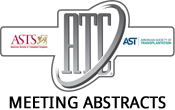2016 American Transplant Congress
Assessing Vaccination Status in Transplant Candidates and Recipients: Current Status and Challenges to Successful Implementation.
Northwestern University Feinberg School of Medicine, Chicago, IL.
Background: Vaccines are safety and efficacy of vaccines in transplant candidates and recipients. Several studies have demonstrated significant underutilization of vaccines which increases the risk…2016 American Transplant Congress
De Novo DQA/DQB Donor Specific Antibodies (DSA) Is Associated with Allograft Dysfunction in Pediatric Liver Transplantation (LT).
Yale New Haven Transplantation Center, New Haven.
Antibody mediated rejection following LT is thought to be uncommon. Studies suggest HLA Ab that bind C1q may be deleterious to the TX allograft, &…2016 American Transplant Congress
Hepatitis B Immune Globulin Withdrawal in HBsAg Positive Liver Transplant Patients.
Introduction: Liver transplantation for chronic hepatitis B virus (HBV) is associated with a high recurrence rate of HBV post-transplant without the use of prophylaxis. The…2016 American Transplant Congress
Live Donor Champion Program: Time to Redefine Living Liver Donation.
UVA Surgery, Charlottesville, VA.
Live Donor Champion (LDC) Programs promote the advocacy for living donor transplantation by patients' family members or friends. Hereby, we conducted a prospective 9 month…2016 American Transplant Congress
Is Pretransplant Determination of Hepatocellular Carcinoma Tumor Grade Using Needle Biopsy Reliable for Transplant Candidate Selection? Analysis of 217 Liver Transplant Recipients.
Department of Surgery, UCLA, Los Angeles, CA.
Objective: Despite the prognostic significance of tumor grade and vascular invasion for patients with hepatocellular carcinoma (HCC), preoperative needle biopsy (PNB) is not routinely utilized…2016 American Transplant Congress
Biliary Epithelial Damage, Regenerative Capacity and Local Immune Response After Cold Storage of DBD Livers Determine Biliary Complications After Liver Transplantation.
Department of Surgery, University Medical Center Regensburg, Regensburg, Germany.
Background: The aim of this study was to examine the development and molecular mechanisms of bile duct (BD) damage between organ retrieval and transplantation and…2016 American Transplant Congress
Subnormothermic Machine Perfusion (SNMP) of Liver Allografts with a Novel Hemoglobin-Based Oxygen Carrier (HBOC) Increases β-Oxidation of Fatty Acids and Decreases Lipid Peroxidation (LP).
University of Pittsburgh, Pittsburgh.
Introduction: There is limited information about the lipid metabolic profile during liver allograft preservation. LP remains a major component of ischemia-reperfusion injuries (IRIs). The aim…2016 American Transplant Congress
Opioid-Sparing Pain Management Improves Outcomes and Safety in Living Liver Donors.
BACKGROUND: As part of the ancillary four center study, to the Adult-to-Adult Living Donor Liver Transplant Cohort Study (A2ALL), over 75% of living liver donors…2016 American Transplant Congress
A Multi-Modular Approach for Training in Liver Procurement Accelerates Proficiency Gain.
BACKGROUND: Modular training has been established as an educational tool in colorectal and urology surgery for the last 5 years. This modular operative approach is…2016 American Transplant Congress
Results from 100 Consecutive Donation-After-Circulatory Death (DCD) Liver Transplants Using a Thrombolytic Protocol.
Multi-Organ Transplant Institute, Ochsner Clinic Foundation, New Orleans, LA.
Background: In early 2010, our center implemented a thrombolytic protocol for DCD liver transplantation in an effort to reduce biliary complications and improve graft survival.…
- « Previous Page
- 1
- …
- 148
- 149
- 150
- 151
- 152
- …
- 180
- Next Page »
